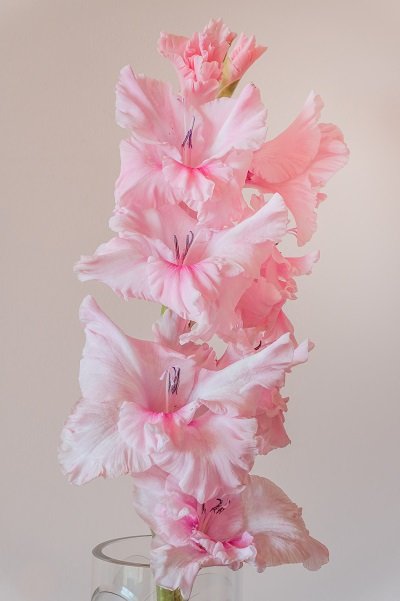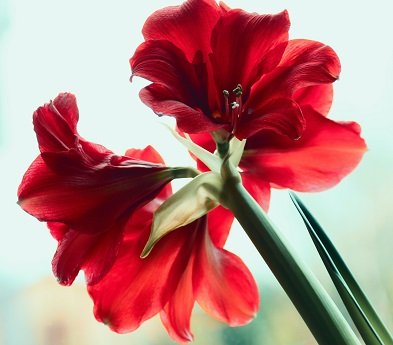The elegant flowers of gladioli, also called irises, embellish all flower beds. Gladioli should be planted from the end of April in very nutrient-rich, well-drained sandy soil. Since summer flowers are sensitive to frost, you need to dig up the tubers and save them.

When to plant gladioli?
Gladioli, also known as irises, beautify every garden and balcony with their lush flowering. In order for the flowers to feel good in the bed or pot, you can plant gladioli in the ground from the end of April to June.
As a rule, in order to plant gladioli, the soil should be frost-free. Don’t expect any more frosts either.
What soil is suitable for gladioli?
The soil should be well-drained, sandy and rich in nutrients. Be sure to plant the bulbs a good six inches deep so that the plants have a stable support later.
Are gladioli annuals or perennials?
Gladiolus (bot. Gladiolus, iris family), also called sword flower due to the striking shape of its leaves or victorywort, is an unfortunately rare bulbous plant with poor winter hardiness. Bulbs should be stored in a dry place over winter and replanted each spring. After the flowering period, you can dig up the bulbs at the end of October. Simply remove the leaves as soon as they fade and shorten the stems a few inches. Remove the soil from the tubers and keep them in the cellar until next spring. More information about wintering gladioli can be found at the end of this article.
With a few tricks and the right choice of the variety of saber flowers, you can extend the flowering period.
Tip: Gladioli are a particularly popular cut flower, available at many pick-your-own establishments. This is then usually the common garden gladiolus, called Gladiolus x hortulanus . These popular cut flowers bloom from June to August and are among the large-flowered representatives.

How to plant gladioli?
The soil should be deeply loosened and fine-tuned with a little humus. Heavy soils should be mixed with sand or perlite, as the bulb does not like waterlogging. For planting gladioli, choose a slightly humid, sunny and free of waterlogging location. The bulbs are placed in a prepared hole with the roots down. A distance of 15 centimeters between the different gladioli plants is ideal. Push the bulbs a little deeper into the ground so that they are covered with soil up to ten centimeters, depending on the size of the bulbs. The long flower stems are then better supported and do not bend as quickly under the effect of the wind.
Tip: Swordflowers also thrive in large pots. You can associate them with other summer flowers , such as dahlias , whether in a bed or in a pot.
Plant new sword flowers with a time shift
The flowering period of saber flowers is quite short, from four to six weeks. To always have new flowers, the gladioli should be planted at different times, so that there is always a week or two between the bulbs. The later the bulbs are planted, the later the flowers will appear. So you will have beautiful inflorescences for a long time, and you can also cut some for the vase. For extra support, you can place a stick next to the bulb and attach the flower stems to it later. This is especially recommended for large-flowered gladioli, which could twist in strong winds and rain.
You can also extend the flowering period by removing faded plants from the bottom. The reason is simple. The purpose of any flowering plant is to produce seeds for reproduction. If you remove the emerging seed heads on the iris, later flowering will be stimulated.

Use variety diversity for long flowering
The expert distinguishes early, medium and late species. It makes sense to combine them consciously if the flowering period is to extend from May or June to September, or even October in mild regions. Among the early varieties are the Byzantium gladiolus (Gladiolus communis ssp. byzantinus) and the Illyrian gladiolus (Gladiolus illyricus), which bloom already in June and until July. When the early varieties slowly stop producing flowers, the mid-range gladioli take over. One of the most common is meadow gladiolus. Among the late gladioli for the garden, which bloom until September, is the butterfly gladiolus, also called butterfly gladiolus (Gladiolus papilio).
Tip: Byzantine gladiolus is one of the few varieties that is conditionally hardy. It is one of the first plants to be introduced into Central Europe in the 17th century. She delights with atypical funnel-shaped flowers and is said to be able to withstand temperatures down to -12 degrees. However, a cover of straw and brush is strongly recommended for this gladiolus under hardiness conditions. In addition, the location should be rather dry, but at least very well permeable to water.
If the plant does not flower…
They really aren’t complicated plants, but sometimes bulbous flowering plants just don’t bloom. The reasons for this situation are as follows:
- The young shoots of the plant suffered frosts.
- They are more likely to be found in shade than in the preferred full sun to partial shade location.
- The gladiolus has been over-fertilized and just grows a lot of foliage as a result.
- Waterlogging or excessively wet, impermeable soil.
Prefer tubers
Want to get an earlier bloom? It is therefore interesting to grow the plants indoors. To do this, fill small pots with normal potting soil in March and place the tubers in them. They should only be two-thirds covered. Place them on a bright windowsill and let them acclimate to outdoor conditions beginning in mid-April when there is no frost. Always come indoors at night until the risk of frost has passed. Plant as usual in the middle, end of May in the garden or in a pot.
Pro Tip: If you overwinter the tubers, you should check them from February or March. If they are already clearly sprouting, it is advisable to pre-cultivate them. Otherwise, your plants may develop long, thin stems in dark storage. This results in thin, twisted shoots afterwards.
winter gladioli
For wintering, seedlings of gladioli, like dahlias, need to be dug up and the bulbs freed from clinging soil. At the latest before the first night frosts or when the foliage has already started to wilt. The leaves stay on the plant until they wilt. This allows the bulb to store the energy it contains. When wilted, they are cut back a few centimeters. It is best to overwinter them wrapped in newspaper in a dark, frost-free place. Make sure the bulbs are ventilated during the winter so they don’t rot. If stored properly, you can replant gladioli next spring and enjoy their elegant inflorescences.
As an option, swordflower, like dahlia tubers, can be overwintered in a dry mixture of soil and sand that you put in a box. This keeps the tubers dry. For wintering, it is advisable to sort out varieties and colors, if you do not want to have a colorful garden after wintering.
The optimum temperature for wintering is ten degrees Celsius.